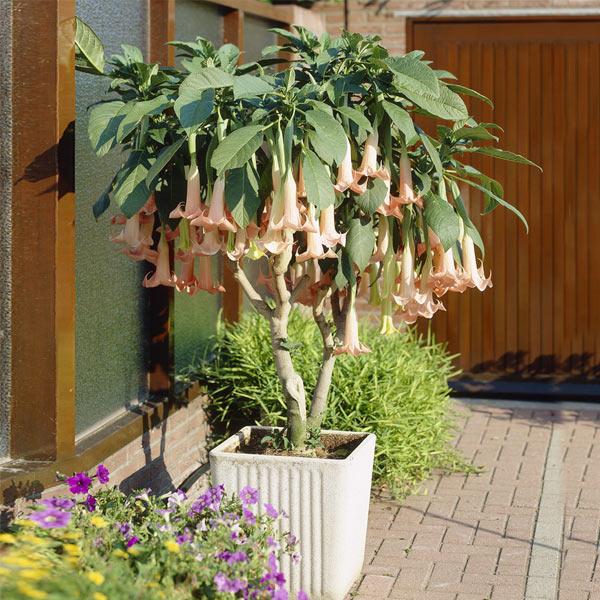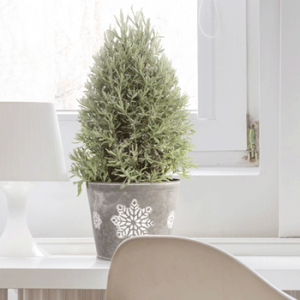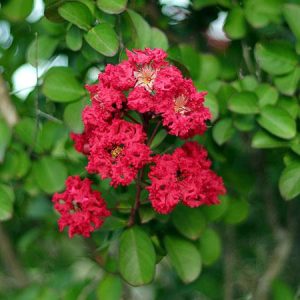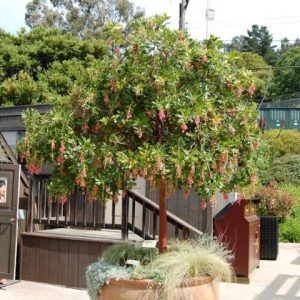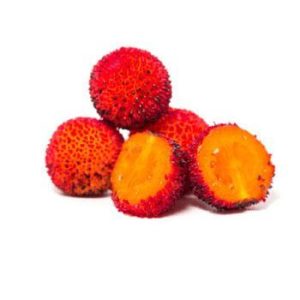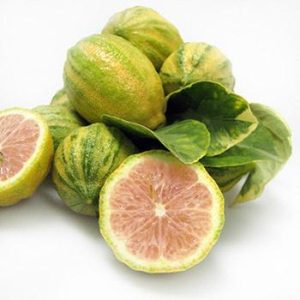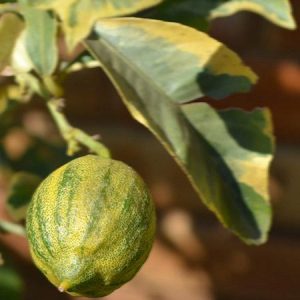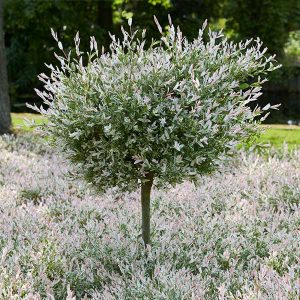Peach Angel Trumpet For Discount
- Estimated Delivery : Up to 4 business days
- Free Shipping & Returns : On all orders over $200
Bring Out Your Exotic Side with the Angel Trumpet
Blooms that are Truly Captivating
You’ll want to showcase the Angel Trumpet where it can get the full attention it deserves. Long white or peach-colored floral bells seductively swing from its branches.
These stunning, tropical trees form a bush-like shape with ash-colored branches extending from a Y-shaped trunk. The dense branches are covered in a massive amount of lush green leaves where it cups the delicate vase-shaped, downward-facing flowers.
Relish Its Beauty for Two Seasons
You’ll enjoy these flowers from summer through fall – and even in the winter in warmer climates. Angel Trumpets, also called moon flowers, bloom in waves – displaying fresh flowers in droves. Somehow, they all magically bloom at the same time
You’ll Have the Best Smelling Yard on the Block
More than just a charming appearance; it possesses a sweet-smelling fragrance that will waft through your yard—inviting you and everyone in its presence to linger and enjoy the delightful scent. The aroma that radiates from the mystifying flowers has been described as a cross between expensive perfume and lemony freshness.
This Unique Plant Requires Little Work
The Angel Trumpet is an easy plant to maintain. All you need to do is water it regularly and make sure it gets enough sunlight to keep it healthy.
This is an adaptable plant. It can withstand heavy trimming, so feel free to shape it however you desire.
Great Container Plant for Colder Climates
If you live in a colder climate—don’t fret, you can still grow an Angel Trumpet. Plant it in a container. The Angel Trumpet works well in large planters. Just remember to bring it inside when the temperature drops below freezing. It will go dormant in a dark garage or basement and will come alive in the spring.
Enhance an entryway or deck with your potted tropical trumpet. Between the beautiful flowers and delightful aroma, it never fails to make a lasting impression.
Order now and we’ll ship this unique plant right to your door. Hurry – this is one of our fast-sellers!
Planting & Care
Seasonal, Location, and Exposure Considerations:
Angel Trumpet is only hardy in USDA Zones 9-12. If you’re growing them in the garden and you’re in colder regions than this, you’ll need to dig them up, retaining as much soil as possible, and move them indoors prior to the first frost in the fall. Angel’s Trumpet prefers a somewhat sheltered site. They flower best in full sun exposures, but they don’t do well when it’s too hot and dry; so provide light shade or diffused sun in these locations. Generally easy, fast growers, that love warm days and cool nights with damp weather conditions.
Soil Preferences
Angel Trumpet loves a rich soil with plenty of organic matter to hold moisture and provide a steady supply of nutrients. Well drained, lighter soils are the best media in which to grow them, whether in a container or out in the garden. To help retain that moist soil environment, use liberal amounts of mulch around the plants.
They prefer slightly acidic soils, with an optimum pH of 6.0 and a range of 5.5-7.0.
Planting and Care – Container Grown or in Pots
Angel Trumpet are often grown in pots. Use large containers for this fast grower. A minimum pot size of 12”-15” is recommended. Water balance will be important, especially in the summer. Use a good quality standard potting mix for best results. Use pots with holes in the bottom so as to not promote waterlogged conditions as they will not tolerate them.
As you plant your Angel Trumpet, be careful to retain as much of the soil that was on the roots as possible, and gently firm the new soil around the roots. Most importantly, water well. Water when the pot is about half full of your new soil, let it settle around the roots, then finish filling and water well afterwards.
If growing your Angel Trumpet indoors, keep it in a warm, sunny location and continue to water as the soil dries out. They are not likely to bloom in the house, however.
For situations where you want to move your potted Angel Trumpet outdoors, you can start bringing it out of dormancy by moving it to a warm area with bright light a few weeks before moving it outside. Remember to increase watering frequency when in full sun. This is also a good time to repot, prune or trim your plant, if necessary. Night time temps should be consistently above 50° before moving your Angel Trumpet outdoors. Pamper it along to acclimate to outdoor conditions, gradually increasing sun and wind exposure.
Container grown Brugmansias will need a lot of water, especially when freshly planted. You’ll find they need to be watered daily, especially in the summer.
Planting and Care – Outdoor Growing in the Garden
In regions suitable for Angel Trumpet, or if you plan to move them indoors later in the season, choose a site that is well drained, with plenty of humus so as to retain water and provide a base level of nutrients consistently to the plant.
Blend a well matured compost and peat mixture into your soil if it’s lacking tilth, nutrients, or isn’t of a ‘fluffy’ nature. Keep in mind, however, they will not tolerate ‘wet feet’. Dig your hole, about twice to three times the size of the root ball you are planting, blend your amendments well with the soil, and set the mixture aside. Place your root ball so as to have your plant’s present container’s soil line be the same as the garden soil line around it. Fill the hole about half way, water thoroughly, and allow the water to drain through the soil. Finish filling, gently firming as you go, then water the entire zone deeply and thoroughly.
Mulch well after planting to help your soil retain moisture. Your new plant may require daily watering as it becomes established. Don’t let them dry out, but don’t drown them either. Once established, you can decrease frequency to 2 waterings week.
Watering
Brugmansia plants need a lot of water while establishing, and when they are actively growing. They will wilt quickly without it. This condition will also encourage spider mites and or whiteflies. Overwatering will encourage slugs and snails, so if your soil may be prone to these molluscs, manage residue and weeds to keep them at bay or try baits if their presence is heavy. They could be a particular challenge on new growth.
Fertilizing
You can fertilize lightly right after planting, then begin feeding every 2-4 weeks using a good, all -purpose fertilizer. You can fertilize during active growth, through bloom. Feed every 2-3 weeks with an all-purpose fertilizer while actively growing or in bloom. It’s recommended to use a water soluble, general purpose fertilizer. Angel Trumpets grow fast, so they will feed heavily. Slow-release formulations are hence not recommended. For a nice little touch, switch to a high phosphorus formulation just before the blooming period. Adding a shot of magnesium and sulfate helps maintain the slightly acidic pH, and can be achieved by dissolving about a tablespoon of Epsom salts in a gallon of water and applying it monthly.
Fertilize only during the growing season.
Weed, Insects, and Diseases
Hand weed under the plants when they are young. A layer of mulch is advisable to hold water, suppress weeds, and it will slowly break down to provide a steady supply of baseline nutrients to the plants.
Pruning and Training
Brugmansia plants respond well to trimming and pruning. Light trimming of older growth throughout the season encourages additional blooms. The blooms arise on new wood, at the terminal ends of the branch, so they can be pruned anytime you want to shape. It takes about a month or more for blooms to appear post-pruning. As a result, many folks choose to prune in the early spring, such as when you are preparing the plant for moving outdoors. Primary cuts should be made ½” above the node for removing older branches. This encourages more branching. Pruning can begin when the main trunk “Y’s”; then prune older stems so as to encourage more prolific branching.
| Size | 3 Gallon, 5 Gallon, 1-2 ft., 2-3 ft., 3-4 ft., 4-5 ft. |
|---|
